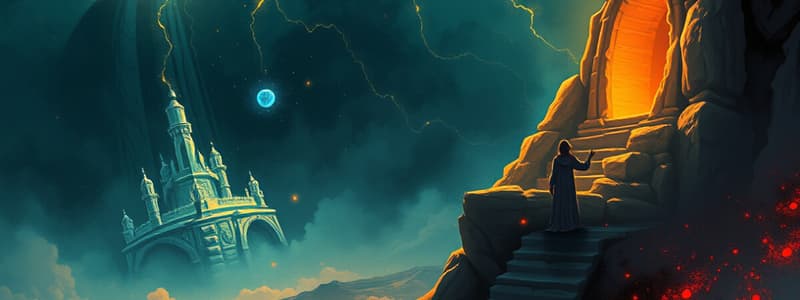Podcast
Questions and Answers
Match the following plot elements with their definitions:
Match the following plot elements with their definitions:
Climax = Crisis or turning point in the plot Exposition = Introduction presenting background Resolution = Conclusion of events Denouement = Falling action that follows the climax
Match the following terms with their meanings:
Match the following terms with their meanings:
Rising Action = Events build towards the climax Plot = Arrangement of events for a purpose Theme = Idea or topic a literary work suggests Setting = Location, time period, and background of a story
Match the following literary elements with their descriptions:
Match the following literary elements with their descriptions:
Climax = Point of highest emotional intensity Falling Action = Shows consequences post-climax Exposition = Initial presentation of story background Plot = Sequence of events manipulated for a conclusion
Match the following narrative components with their order in the Dramatic Arc:
Match the following narrative components with their order in the Dramatic Arc:
Match the following terms with their associated concepts:
Match the following terms with their associated concepts:
Match the following definitions with the correct plot element:
Match the following definitions with the correct plot element:
Match the following pairs of terms and functions:
Match the following pairs of terms and functions:
Match the following literary terms with their characteristics:
Match the following literary terms with their characteristics:
Study Notes
Key Terms in Plot Structure
- Climax: Derived from Greek meaning "ladder", representing the turning point in a plot where conflict reaches peak emotional intensity and suspense.
- Denouement: Originating from French meaning "unknotting", this phase follows the climax and addresses the consequences of the main conflicts, revealing the final state of characters' affairs.
Components of Narrative Plot
- Exposition: This introduces the story, providing necessary background and backstory to contextualize the plot.
- Rising Action: A series of events that build tension and develop the conflict leading up to the climax.
- Resolution: The conclusion where conflicts are resolved and the story reaches its end.
Understanding Plot
- Plot Definition: Also referred to as the storyline, it is the structured arrangement of events to justify a conclusion, which involves manipulating the sequence for narrative effect.
- Events Management: Involves abbreviation, expansion, or reordering of events to serve the story's purpose.
Additional Elements
- Setting: Encompasses the geographical location, time period, and cultural background of the story, establishing the context for the narrative.
- Theme: Represents the core idea or topic that the literary work aims to explore, argue, or suggest.
Studying That Suits You
Use AI to generate personalized quizzes and flashcards to suit your learning preferences.
Description
Explore the crucial components of plot structure in fiction and drama, focusing on climax and denouement. This quiz covers definitions, significance, and examples of these pivotal narrative elements. Enhance your understanding of how tension builds and resolves in storytelling.




